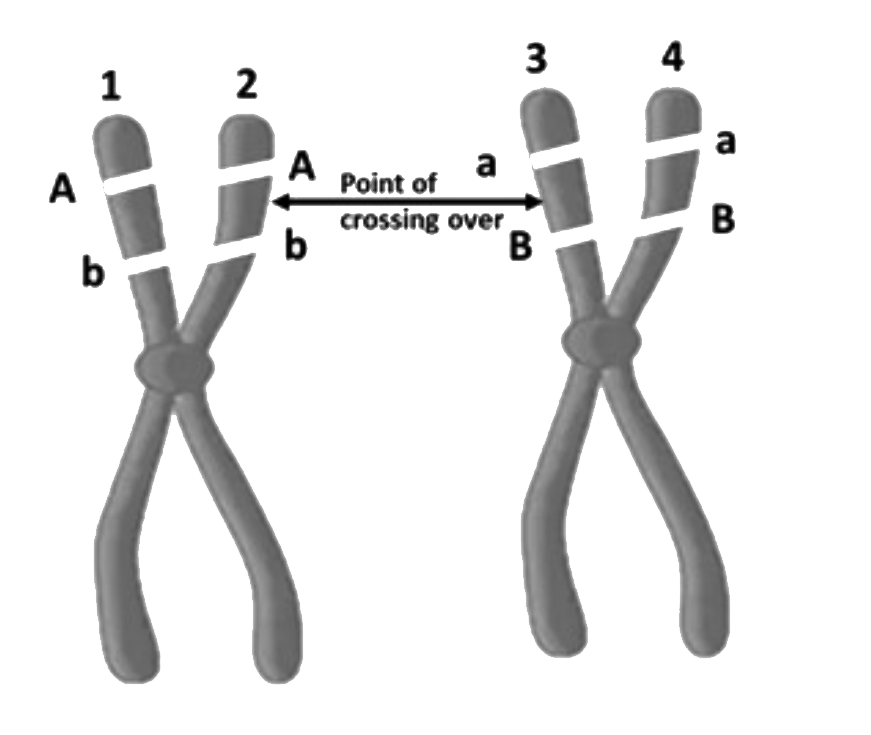What is crossing over ?
Step-by-Step Solution:
1. Definition of Crossing Over:
- Crossing over is a biological process that occurs during meiosis, specifically in prophase I. It involves the exchange of genetic material between homologous chromosomes.
2. Homologous Chromosomes:
- Homologous chromosomes are pairs of chromosomes that have the same genes at the same loci but may have different alleles. Each parent contributes one chromosome to the pair.
3. Mechanism of Crossing Over:
- During meiosis, homologous chromosomes align closely together in a process called synapsis. At this point, sections of chromatids from one chromosome can break and reattach to the corresponding sections of the other chromosome.
4. Formation of Recombinant Chromosomes:
- The result of this exchange is the formation of recombinant chromosomes. These chromosomes have a mix of alleles from both parents, which increases genetic diversity in the offspring.
5. Importance of Crossing Over:
- Crossing over is crucial for genetic variation. It ensures that each gamete (sperm or egg) contains a unique combination of genes, which is essential for evolution and adaptation.
6. Applications of Crossing Over:
- The principles of crossing over are applied in various fields, including agriculture, where it is used for crop modification and breeding programs to enhance desirable traits.
- Crossing over is a biological process that occurs during meiosis, specifically in prophase I. It involves the exchange of genetic material between homologous chromosomes.
- Homologous chromosomes are pairs of chromosomes that have the same genes at the same loci but may have different alleles. Each parent contributes one chromosome to the pair.
- During meiosis, homologous chromosomes align closely together in a process called synapsis. At this point, sections of chromatids from one chromosome can break and reattach to the corresponding sections of the other chromosome.
- The result of this exchange is the formation of recombinant chromosomes. These chromosomes have a mix of alleles from both parents, which increases genetic diversity in the offspring.
- Crossing over is crucial for genetic variation. It ensures that each gamete (sperm or egg) contains a unique combination of genes, which is essential for evolution and adaptation.
- The principles of crossing over are applied in various fields, including agriculture, where it is used for crop modification and breeding programs to enhance desirable traits.
Topper's Solved these Questions
- CELL CYCLE AND CELL DIVISION BOOK - AAKASH INSTITUTE ENGLISHCHAPTER - CELL CYCLE AND CELL DIVISION EXERCISE - Try Yourself
30 Videos
- CELL CYCLE AND CELL DIVISION BOOK - AAKASH INSTITUTE ENGLISHCHAPTER - CELL CYCLE AND CELL DIVISION EXERCISE - EXERCISE
20 Videos
- BREATHING AND EXCHANGE OF GASES BOOK - AAKASH INSTITUTE ENGLISHCHAPTER - BREATHING AND EXCHANGE OF GASES EXERCISE - ASSIGNMENT SECTION - D
11 Videos
- CELL:THE UNIT OF LIFE BOOK - AAKASH INSTITUTE ENGLISHCHAPTER - CELL:THE UNIT OF LIFE EXERCISE - Try Yourself
26 Videos
Similar Questions
The segment of DNA which participates in crossing over is termed as
View SolutionTwo homologous chromosomes are depicted in the diagram given below. Crossing over occurs between chromatid 2 and chromatid 3 at the point as depicted .

The gametes produced as a result of this crossing over will be
View Solution
Knowledge Check
Assertion: The crossing over is an enzyme-mediated process.
Reason: The enzyme involved in crossing over is lyase.AIf both assertion and reason are true and reason is the correct explantion of assertionBIf both assertion and reason are true but reason is not the correct explnantion of assertion.CIf assertion is true but reason is false.DIf both assertion and reason are false.
The points at which crossing over has taken place between homologous chromosomes are called synaptonemal complexes
View SolutionEnzymes help in crossing over
View SolutionIn meiosis crossing over is initiated at
View SolutionIn meiosis crossing over is initiated at
View SolutionThe points of crossing over in meiosis appear as
View SolutionWhich one of the following shows crossing over and variations
View SolutionSynapsis, crossing over, chiasma formation and interkinesis.
View Solution